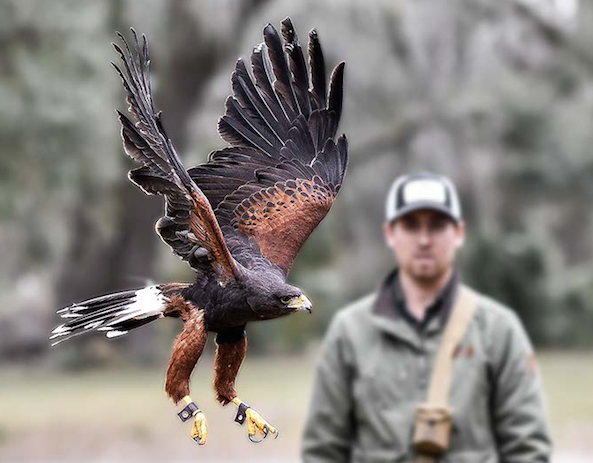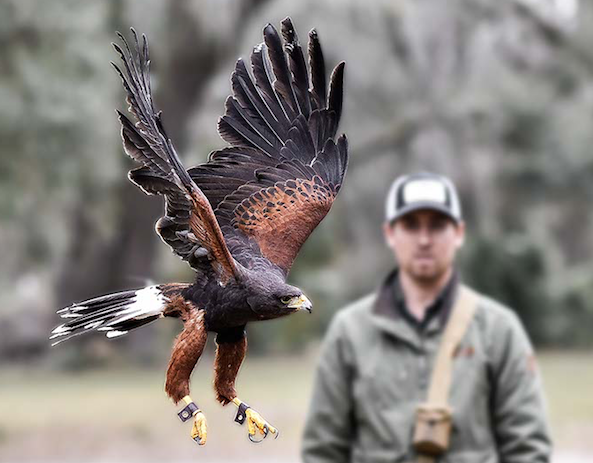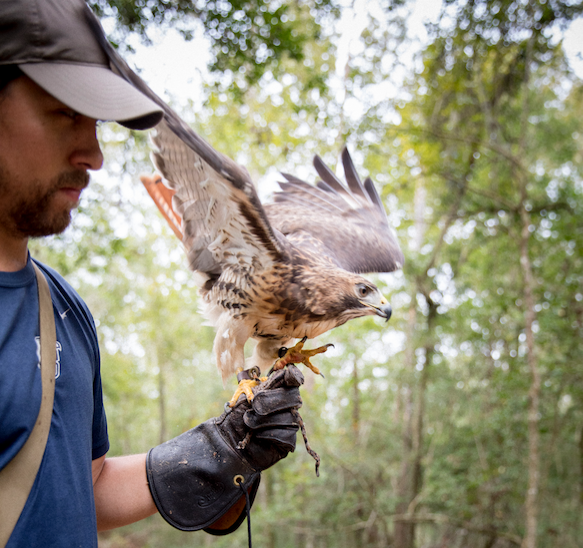Why a Falconry Hunt Is the Wildest Thing You Can Do Outdoors
Death from above.


I recently spent an afternoon with a bloodthirsty killer. Doyle is a 15-year-old Harris’s Hawk with a three-foot wing span, a scarily-intense gaze and powerful talons that belie the fact that he weighs just a pound-and-a-half.
Doyle kills his prey—be it bird, squirrel, mouse, rat, mole, rabbit, shrew or snake—by crushing it with his muscular feet and razor-sharp claws. He is as deadly accurate as a hunter wielding a rifle, but he’s way more fascinating to watch.
I meet Doyle during a falconry hunt in South Carolina’s Low Country, as we navigate through a rugged patch of long-leaf pine trees, saw palmetto and whiskey grass. The expedition is led by father-and-son falconers Steve and Adam Hein, who bring along a Hungarian Vizsla hunting dog and several hawks and falcons, all transported in the back of their yellow 1977 International Scout II truck.
First up is Doyle, who soars high up onto a pine tree as the dog begins sniffing out birds hiding in the brush. The hawk follows the dog’s movements, flying from tree to tree. Within minutes, the dog freezes and points toward a tall patch of grass.
A chukar partridge tries to flap out of harm’s way, but it’s too late. The hawk swoops down and hits the smaller bird like a guided missile. There’s an explosion of feathers, and the hawk pins his prey to the ground….then begins devouring its innards.
Adam Hein, who co-owns a Georgia-based falconry-and-fly-fishing company called On the Fly Outfitters, diverts the hawk’s gory focus by feeding him a chunk of quail meat as it perches on a falconry glove (see Doyle eating in the video below). After the dog retrieves what’s left of the chukar, I ask how strong the hawk’s grip is.
“Considerably more than the strongest human,” Adam says. “These smaller hawks are close to 200 pounds-per-square-inch, and the Red Tails are closer to 500 to 600 PSI. You can get into bigger birds like eagles and it’s around 1,000 PSI.”
“A ten-pound bird is going to have a stronger killing mechanism in their feet than a dog or a wolf would in their jaw, which is kind of crazy if you think of a 100-pound dog versus a 10-pound eagle.”
Yes, birds of prey are definitely badass, and no, you probably wouldn’t want to shake hands with them. We use hawks for this afternoon’s hunt because they are best at catching prey in wooded terrain. Falcons, which are smaller and faster, are better suited for wide-open spaces where speed is paramount.
The peregrine falcon, after all, is the world’s fastest animal. Their cruising speed is between 40 and 60 mph, but they can reach diving speeds of more than 200 mph, faster than a Formula 1 race car.
Or to make another sports analogy, consider that old boxing adage of “speed kills.” Falcons don’t possess the critter-crushing foot strength of hawks, but they make up for it with terrifying velocity—and the punching power that comes with it.

“They actually ball up their foot into a fist and punch their prey,” Adam explains. “If they can’t debilitate it enough to kill it, they have an adaptation on their beak where they go in and sever the spinal cord.”
Later, we unleash a Goshawk named Harry, who takes flight right off Adam’s glove, as opposed to Doyle, the Harris’s Hawk who prefers flying from tree to tree before attacking his victim.
“This is a very explosive bird,” says Adam’s father, Steve Hein, a master falconer and director of Georgia Southern University’s Wildlife Center. “He’s looking for any twitch of a bird, rabbit—anything that moves. This is a bird that can actually catch anything. Feather or fur.”
Harry chooses feather this time, and quickly picks off another chukar that erupts out of the grass. Feathers rain down from their midair collision and Harry tears into his lunch. Later, we watch Ali, a young female Harris’s Hawk, catch a squirrel, drop it, then catch it again, before the battered rodent somehow manages to scamper up an oak tree into a hole to live (or die) another day.
“This predation goes on 24/7. Whether we’re here or not, there are birds of prey doing exactly what we’ve witnessed,” Steve says. “We’re just kind of bystanders. This is theater in the woods, but it’s a serious game. It’s life and death. And we have the privilege of being able to see it.”
Aside from being a a 4,000-year-old-sport that offers a remarkable window into nature’s brutality, falconry has even shaped our everyday language, thanks to 16th-century amateur falconer William Shakespeare, whose plays carry numerous falconry references. “Wrapped around your little finger,” for example, was inspired by a falconry leash. “Hoodwinked” is derived from the mask falcons wear to keep them calm during training.
The falconry hunt is a highlight of Field + Fire, an annual weekend getaway at Palmetto Bluff, a sprawling, 20,000-acre luxury resort in Bluffton, S.C. It’s the kind of place where you can drop $100 grand on a bespoke British shotgun or $12 grand on a giraffe bone hunting knife, all while a twangy cover band plays Chris Stapleton’s “Tennessee Whiskey” next to the merchandise tables.
https://www.instagram.com/p/BeOLirYlDNh
Local artisans peddle bow ties made from wild turkey feathers, outdoorsy oil paintings, and a variety of duck and waterfowl decoys. There are demonstrations of bird calls, fly-fishing techniques and dog handling, and a bourbon-paired game dinner to cap it all off. But the falconry hunt, and the rare opportunity to see these magnificent birds up close, was easily the weekend’s coolest experience.
Later, after the hunt is over, I catch up with Steve as he loads the birds back into his truck. So, how does one actually become a falconer, anyway?
“To practice falconry in the United States, you have to apprentice,” he says. “You have two years as an apprentice. You have to take a state and federal test. You have to score a certain grade to pass the test and apprentice under someone who is a general or master falconer.”
“Then you spend two years as an apprentice, five years as a general falconer. After a combined seven years, you’re a master falconer.”
OK, good to know. And for those of us who don’t want to pursue it as a full-on vocation, what can we learn from this ancient pastime as mere bystanders?
“As far as the takeaway, it’s up to the individual. For me, I think falconry, above all else, is a natural history sport. Yes, it is hunting. And yes, it is a 4,000-year tradition. But when I say a natural history sport, you have to know nature. You have to be a student of nature.”
“It’s a privileged point of view to see nature the way it actually is. We kind of voyeuristically had the opportunity to watch what really goes on. And that’s the good, bad, and the ugly.”
Schedule a falconry hunt with Steve Hein’s Center For Wildlife Education, and/or with son Adam Hein’s On the Fly Outfitters.
